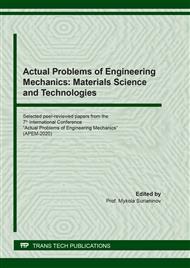p.141
p.149
p.158
p.164
p.175
p.180
p.191
p.198
p.204
Research of the Reasons of Frost Destruction of Road Concrete
Abstract:
The article analyzes the causes of the destruction of road concrete in the winter. The basic theories of concrete failure during freezing are presented. Hypothesis of R. Collins according to which the destruction occurs as a result of the pressure of ice, which is formed when water freezes onto the pore walls. The hydraulic pressure hypothesis of T. Powers, according to which the main cause of concrete destruction during cyclic freezing and thawing, is the hydraulic pressure that creates water in the pores and capillaries of concrete under the action of ice. The hypothesis of thermal destruction of concrete due to the difference in the coefficients of linear thermal expansion of its components. In winter, sodium chloride (NaCl) solutions are most often used to combat ice on the surface of road surfaces. Therefore, an important consequence of this may be osmotic pressure. To calculate the osmotic pressure, the Vant-Hoff formula for true solutions was used. The maximum values of the osmotic pressure were determined at temperatures of 255...293 K. The critical concentrations of sodium chloride solutions at which concrete was destroyed were calculated. It was established that at the initial stage of freezing-thawing of concrete with the simultaneous action of an aqueous NaCl solution, the structure of concrete is densified and its strength is increased.
Info:
Periodical:
Pages:
175-179
Citation:
Online since:
September 2020
Authors:
Price:
Сopyright:
© 2020 Trans Tech Publications Ltd. All Rights Reserved
Share:
Citation:


